If Google is showing you this page first, click here to go to the start of the article.
Design and Build Quality
Casing
Tiny but mighty, the iFi Audio Uno gave me a strong impression right out of the box. If priced like an USB Dongle such as the FiiO KA2 or iBasso DC03 Pro, this new DAC/Amp came up with a body almost thrice that size and a RCA output, like the old but mighty NuForce microDAC.
As expected from the picture, it’s a shoe-horned version of the Zen series, matching the classic Zen One/DAC design, but (almost) pocket sized. Speaking of that, the Uno measures 88 x 81 x 26 mm, and weighs 92g, decent numbers that shall allow you to carry it in a bag, a pouch or even a confidently big jacket pocket.
In fact, the brand advertises the DAC as small enough to fit into the palm of your hand, which is true, but this one clearly seems dedicated to fit a desktop, rather than being carried on-the-go like the Go Blu, or even the Go Bar.
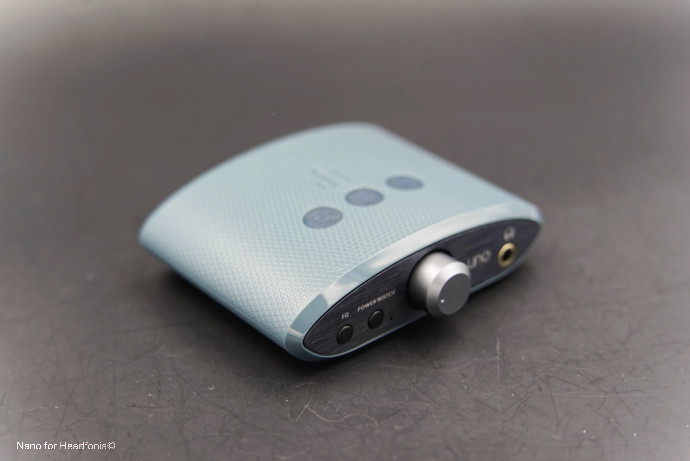
The eye-appealing feature is, of course, the small potentiometer, something that’s always missing in this price-range – even more on dongle-sized USB-DAC. For this kind of device, it really is a must and if I prefer buttons to wheels for my portable devices, this controller perfectly benefits the Uno, once connected to a source.
The DAC itself is very well-built. A main body made of plastic – or tough, mineral-filled polymer if you listen to iFi’s market team – covered on each side by brushed aluminum plates. The headphone jack feels sturdy enough to withstand some in/out abuse, the line-out ports are perfectly aligned and most of all, the volume potentiometer gives a confident feeling when turned.
Overall, it’s a balanced design and, for the price, you should not be disappointed in this regard.
Layout
The iFi Audio GO Uno I/O is surprisingly extensive for a $79 DAC/Amp and only misses a balanced output, in case you’d need to plug a power-hungry headphone.
On the front you get:
- 3.5mm TRS classic headphone output to connect your gear the regular way
- An EQ button, that allow you to switch between three different modes – Gaming, Music, Movie
- A PowerMatch button, to switch between low and high gain
- and, finally, a very nice-looking volume potentiometer
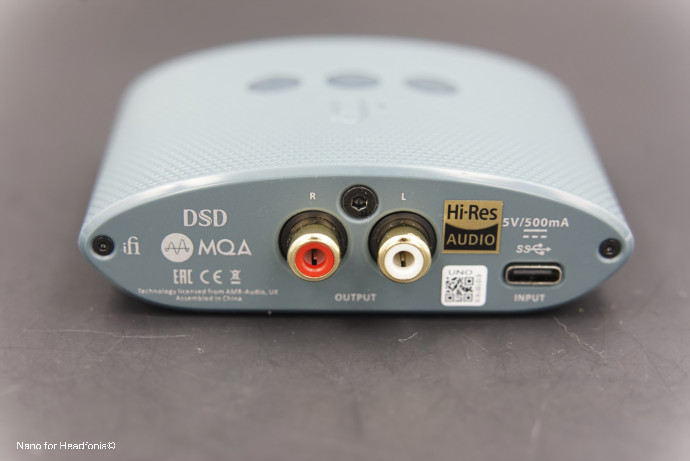
On the back you’ll find :
- the USB-C port, to connect your Uno to your digital source
- a RCA line-out, in case you’d like to connect your DAC to an (headphone) amp, or even a set of powered speakers
Last but not least, you’ll be surprised to find three silicon buttons, on top of the DAC, which aren’t! In fact, those are indication LED that highlights the EQ mode you’re actually using at the moment.
A neat product through and through that borrows a lot from the Zen DAC, for the best..
UI and Usage
Everyday Use
The iFi Audio Uno could not be simpler to use.
Just plug the USB cable into your computer/streamer/tablet, connect the other side to the Uno, and you’re good to go. Pairing is ultra-simple, all you have got to do is turn on the device with the volume controller, wait for the top-light to turn on, “et voila. I tried the device on my MacBook, an iPad and even my new Xbox, all recognized the Uno almost immediately – like every USB-DAC should in 2023.
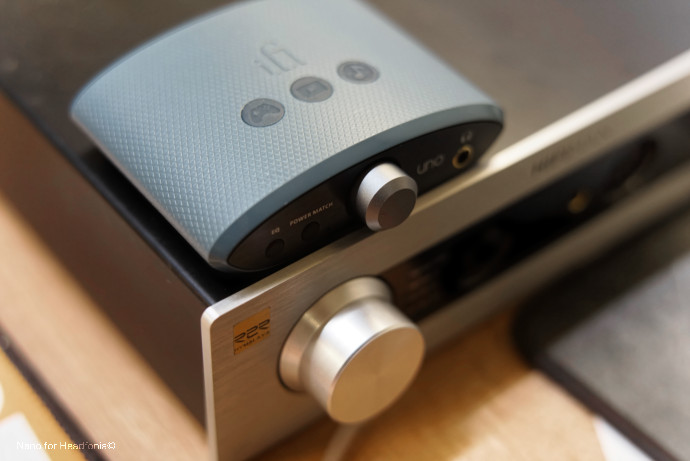
And, if I miss a balanced output, the RCA Line-out on the back is more than welcome! The ability to plug the Uno on my powered-speakers (KEF LS50 Wireless) was more than appreciated and I’m sure that many listeners would easily exchange their 4.4mm Pentaconn output, for a true line-out when in desktop mode. The volume knob is smooth with a long single course and a wide volume range, completed by a Hi/Lo gain button (the powermatch) and the famous EQ settings.
Personally, if the idea of getting three embedded EQs looked interesting, I ended up using the Music mode solely, or no EQ at all. The Movie mode sounded a bit too bright and the Gaming mode, if fun with the enhanced low-mids – became a bit too prominent during long listening sessions.
Power and drive
Surprise, surprise, the iFi Uno was able to output enough power to drive some of my sedentary headphones. I tried my Sennheiser HD800S, the Audeze LCD-X and if not deafening, the end result was more than enough considering the size of the device. Of course, if you want power in a tiny form, your best bet will be the Chord Mojo 2, but it’s also quite expensive…
I also paired the DAC with various headphones and IEMs, ranging from my faithful Audeze LCD-X, or the delightful Meze 109 Pro (great headset), and none really gave the small Uno any issue. Of course, it cannot match the classic iFi Zen Amp, but for a device this small, it’s surprising to see how powerful it gets.
If you really need more power, maybe you should check the GO Bar from the same brand, or the FiiO Q7 – big love on that one.
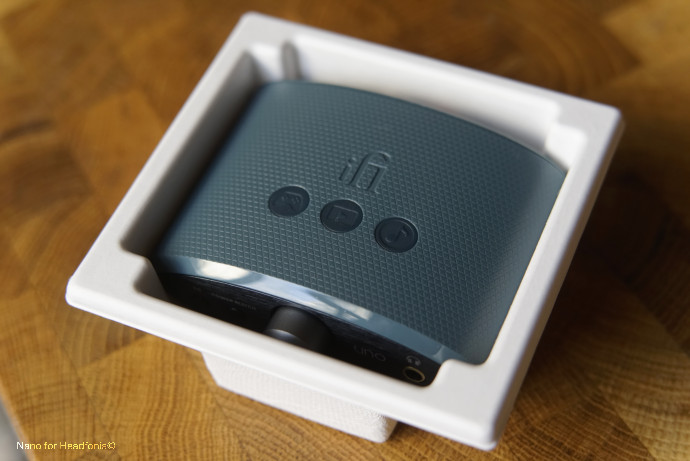
Bundle
The iFi’s Uno bundle is pretty dire, but that was to be expected.
Inside the box you have :
- 1x iFi Uno
- 1x USB-C to USB-A cable
And… that’s it. I thought the brand would add some pads or something to hold the iFi’s, but that’s not the case and, to my surprise again, the silicon band located on the bottom part potently held the Uno on my desktop.
On that good word, let’s check the specs.
Specifications
Sabre ESS 9219MQ/Q + Dynamic Range Enhancement
Instead of the usual Burr-Brown chip, the iFi Uno is packed with an ESSTech chip, the ES9219MQ/Q in this case. A new DAC that I have only encountered once, on the FiiO KA1, designed audiophile-grade portable power sensitive applications such as DAP or USB DACs.
It offers the usual ESS Tech features you’d expect, namely:
- full high-resolution PCM decoding, up to 32bit/384kHz
- native DSD support up to DSD256
- 64-bit accumulator & 32-bit processing
- QUAD DAC+ technology which shall offer “unprecedented dynamic range & ultra-low distortion”
- A user-programmable FIR filter with user presets, namely the 3 EQ settings
- up to 121dB DNR and –114dB THD+N in HiFi mode
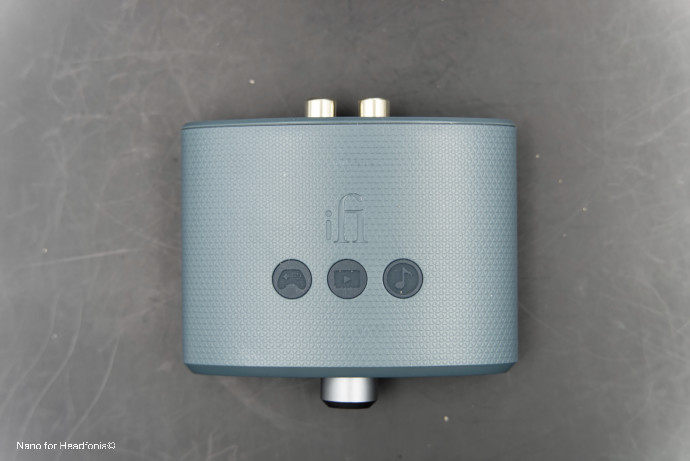
As usual, you can top that with 32-bit HyperStream II architecture, Time Domain Jitter Eliminator and a whole new THD compensation + Analog THD Removal, designed to minimize DAC nonlinearity – especially useful in USB.
But, the true novelty here is the new Dynamic Range Enhancement (DRE), a feature embedded in the DAC, but enhanced by iFi’s proprietary technology. On paper, the tech team managed to extend the dynamic range by a full 6dB – impressive number – for an improved listening experience.
S-Balanced + Global Master Timing
Yet, the “piece of resistance” remains the S-Balanced circuitry. iFi advertises the system as “Whether you use balanced or unbalanced headphones, you get the least noise and best channel separation for the most enjoyable music”. A cool feature that “delivers maximum performance from single-ended and balanced headphones alike”. On that regard, I just want to quote iFi’s own presentation – as good as it’s funny.
Of course, the iFi Uno also gets TDK and muRata capacitors to ensure a minimal level of noise, even when Bluetooth is in use. To that, you can add iFi’s usual GMT clock, an extensive jitter-eradication technologies are applied to the digital stage, including femto-precision clock and intelligent memory buffer.
For the nerdiest one, here are the full technical data, for the rest, you can go to the next page already.
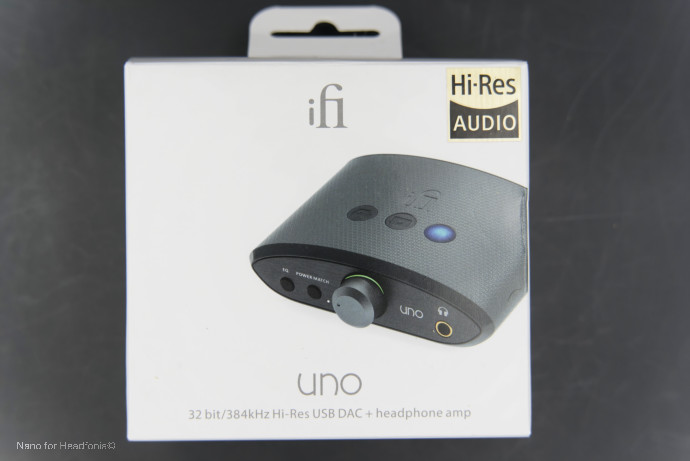
Technical Data
- Model: iFi Audio Uno
- Type : USB DAC/Amp
- Outputs: 3.5mm Jack / RCA Line-out
- DAC: Sabre ESS 9219 MQ/Q
- THD: 0.02% (3.5mm) / 0.03%(RCA)
- SNR: > 113dB (3.5mm) / 119dB (RCA)
- Channel separation: >80dB
- Power output: 211mW @ 32Ω; 39mW @ 300Ω / 2V (RCA)
- Output impedance: near 1 ohm (3.5mm) / 100 ohm (RCA)
- Frequency Response: 20Hz – 20kHz (0.3dB)
- Size: 88 x 81 x 26 mm
- Weight: 92g
- Price: $79
The review continues on Page three, after the click HERE or by using the jump below.
Page 1: about the brand
Page 3: Sound performances, conclusion






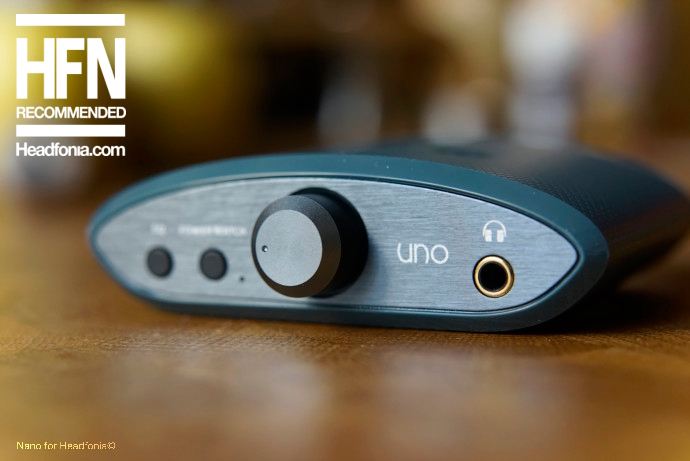


Victor
Would there be any reason not to connect it to an integrated amp using RCA and use it as a DAC for my speakers? The article only talks about headphones and powered speakers.
Power aside, how does it compare to the Zen DAC 2? Does it improve on sound?
MarcoGV
Victor, I tried using it as a DAC for the LEPAI LP-2021 TI amplifier I use for my desktop setup, where it powers a pair of B&W 600 series 2 speakers with very nice results. Using the Uno as a DAC works, but with a quirk. First, the RCA output is not line-level but is controlled by the volume control; this is an odd design choice; it would be more convenient to have a fixed level when using the Uno as a DAC, for the reason I give in the second paragraph. Second, if you plug in the headphones in the Uno using the front output, the RCA output is muted; this to me makes sense.
The combination of these two choices leads to the following problem. Normally, you would keep the volume at maximum when using the Uno as a DAC. So, you need to remember to turn down the volume on the Uno when plugging headphones in (or risk blowing them up). Again, in my opinion, the choice to mute the RCA output when plugging in headphones is fine, but the choice to have the RCA output controlled by the potentiometer is bad. Others may disagree.
lanqiuer
Agree. It works with a quirk. My uno has its front and rca output working simultaneously.